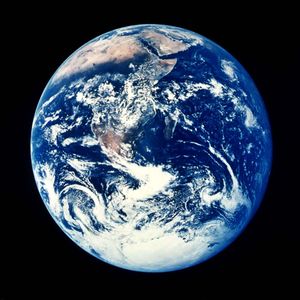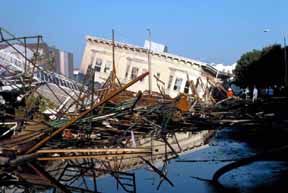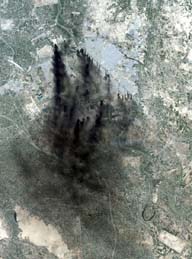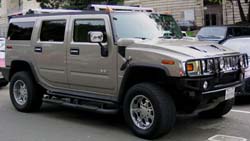War on Terra
The War on Terra is the unofficial name for a series of policies initiated by the United States in response to a series of attacks against civilian populations and other national interests conducted by extremist weather fronts led by Mother Nature, reputedly on behalf of Planet Earth. In late 2001, President Bush declared total war on Planet Earth and all nation states and ecosystems harboring life. To these ends, the Bush administration began to implement the following policies:
- Use of preemptive strikes against the environment and other locations which harbor extreme nature and life.
- Suspension of the rule by laws of nature to more effectively pursue potential suspected plots and acres containing petroleum and other resources that might aid life and terra.
- Massive homefront mobilization of civilians and industry to better marshall resources against domestic sources of nature.
Terra Before 2001
Terra Attacks in the 1980s

From the beginning of the 1980s, sporadic terra attacks inflicted damage to U.S. civilians and economic interests. On May 18, 1980, Mount Saint Helens blew up and killed 57 civilians in Washington state. Later that year, sleeper cells of terra retroviruses from Africa awoke in major urban centers. The resulting AIDS epidemic, which inflicted heavy casualties in several large American cities, including New York, Los Angeles, Chicago, and San Francisco, appeared to represent another victory for nature over civilization.
With thousands dead, the Reagan administration conducted a series of strikes and assaults against nature throughout the eighties. Fierce anti-nature activist James Watt was appointed Secretary of the Interior. Watt led many successful attacks on forest ecosystems and terra cells in the American west. Still, the dark toll on the American psyche was large. The personal and emotional scars left by the 1980 attacks ran so deep, that Reagan was emotionally unable to talk about AIDS and its victims until 1987. His silence will always be remembered by the American people.
Eventually, terra attacks seemed to wane. But at the beginning of the first Bush administration, nature extremists struck back at America’s technological heartland. The Loma Prieta earthquake on October 17, 1989 caused 66 deaths and inflicted $6 billion of damage in the Bay Area. This new strike, which occurred during the 1989 World Series, again moved America into action.
Accommodation and Negotiation in the 1990s
During the latter half of the first Bush administration and during the Clinton administration, efforts were made to reach a negotiated settlement with the forces of nature. A series of accords and treaties were reached, culminating in the Kyoto accords in the late 1990s, negotiated by Al Gore. It seemed that peaceful coexistence of nature and Planet Earth with America was imminent. However, a new threat to America had been developing. Richard Nixon, as part of an effort to oppose the Soviet Union, had secretly begun funding of the EPA in 1970. One of its radical leaders, Mother Nature, would come to pose a major threat to America.
The War on Terra Begins
In early 2001, the selection of Bush as president left the American people feeling optimistic. However, later that year, a series of attacks led by the forces of Mother Nature would shock America. In early June, an extreme weather front, Tropical Storm Allison, devastated Houston, Texas, killing 22 civilians and causing $5 billion of damage. An even more shocking attack occurred on September 11, as forces of gravity and oxidation, groups allied with Mother Nature, effected the collapse of the World Trade Center in New York City.
The Search for WMD
The attack on Houston had been one in a long series of attacks caused by extremist ocean ecosystems on the United States. The elimination of ocean ecosystems soon became a priority of U.S. foreign policy. In early 2002, the United States struck Afghanistan. Eventually, all ocean ecosystems harbored by the Afghan Taliban regime were eliminated and destroyed. In October 2002, the United States implemented policies designed to restrict the flow of critical components of the ocean ecosystem: whales, marine life, and diatoms (or WMD).
In 2003, Bush ordered a controversial invasion of Iraq, justifying the attack by saying that Iraq was harboring a desire for ocean ecosystems. In August 1990, Saddam Hussein had invaded Kuwait, a country rich with coastlines and teeming with ocean ecosystems. This attack was successfully repulsed by the first President Bush. Fearing that Saddam Hussein would make another attempt at acquiring WMD necessary for constructing an ocean ecosystem, Bush ordered military strikes in March 2003. Thus began the occupation of Iraq.
Expansion of the War on Terra
While it became clear the Iraq lacked WMD, it also became clear that Iraq was harboring life and other agents under the control of Mother Nature. The War on Terra gradually expanded to include not just WMD, but the elimination of all life. Warheads containing uranium and other radioactive materials were dropped in massive numbers across Iraq. The policies that would later become the War on Terra began to take shape.
The Domestic Front Opens
It soon became apparent that the War on Terra could not be conducted only internationally. Domestic action was also required. Nature was active throughout the United States in both rural and urban areas. Strikes against Mother Nature were ordered by President Bush throughout the American west. Yellowstone, a well-known nature stronghold teeming with wildlife and volcanic activity, was invaded with snowmobiles. Attempts were made to invade the Arctic National Wildlife Refuge, another nature stronghold, with oil drilling. Through the western states, forests and prairies, strongholds of Mother Nature, were laced with mines.
The American Public Responds
The American people, emotionally enraged by shark attacks and extremist weather that devastated Florida in 2004, and led by the example of President Bush, began to make large sacrifices to win the War on Terra. Many Americans traded their personal wealth for sport utility vehicles, weapons which destroyed the atmosphere and climate necessary for Mother Nature to thrive. Many more Americans generated trash and pollution, thus personally participating in the destruction of ecosystems and life. By 2005, the American way of life seemed geared to winning the War on Terra and eliminating all life on earth. Never had a nation been so unified and willing to make sacrifice.
Suspension of the Laws of Nature
As Americans began to be personally involved in the War on Terra, the legal system began to change. The Laws of Nature, to great controversy, were suspended. Evolution was overturned. Persistent vegetative states were ruled illegal. Global warming was suspended. While the suspension of the Laws of Nature caused much international dismay, most of the American public acquiesced to the new policies.
The Future of the War on Terra
By July 2005, the War on Terra was being fought on every corner. Successful attacks had been made on all major ecosystems. New weapons of mercury and arsenic had destroyed much of the water base of Mother Nature. The destruction of Planet Earth and all life seemed within reach. Preliminary work for the destruction of Mars and the Moon had begun. Many believe that the War on Terra will be one of the enduring legacies of President George W. Bush.





